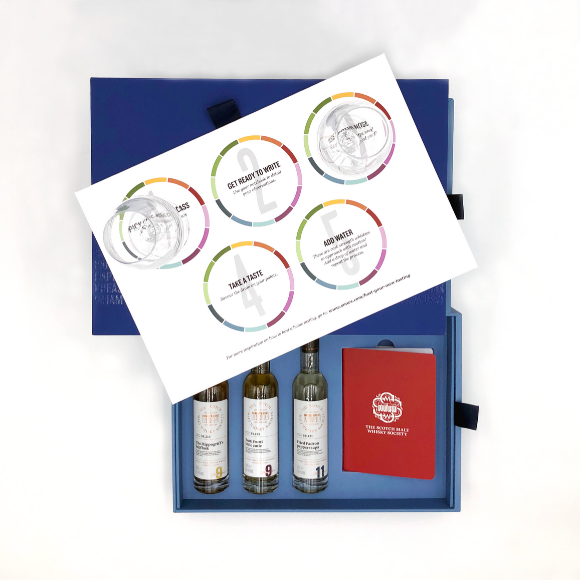Knockando
From Ledgers to Computers: the Knockando Story
First Society bottling in 1993.
ANTHONY TROON finds traditional standards live on in the Speyside distillery that keeps a wardrobe of forty kilts.
I was looking over the old ledgers in the manager's office at Knockando-Glenlivet. There, in spidery handwriting from 30 May 1898, were the figures that showed how it all began. Bushels of malt - 224; Gallons of wash - 4484; Remaining in store - nil; Depending feints - nil. The fact that there were no feints brought forward from a previous distillation told its own story. This was the record of the first malt whisky ever produced in a distillery which now has a worldwide reputation.
The Knockando ledgers; leather bound and weighty with a solemn feeling of old-fashioned Scottish probity, are, an amazing survival. They were found in an outhouse ", which was about to be demolished, and their detailed, telltale figures reflect all the optiniism and anxiety of starting tip a new mali; whisky distillery from scratch. As I turned the weighty sheets Knockando's manager, Innes Shaw, took a phone call and moved across to his computer. He logged on and there was an exchange of instructions on a radio telephone. The computer started to churn out reams of statistics. We had reached the end of another century: but it occurred to me that through the astonishing changes in technology, from pen and inkwell to microchip, we were saying basically the same things about the same glorious product.
The village of Knockando is remote, beautifully remote. Yet as you drive through the tiny settlement you are in a place of great influence, for the three malts distilled nearby reach out as constituents of major-selling blends on the world stage. Most of the Knockando goes into J & B. Rare which has the second biggest worldwide sales: the Cardhu goes into topselling Johnnie Walker: and the Tamdhu is an essential part of The Famous Grouse.
Such commercial clout was undreamed of when the first entry was made in the first Knockando ledger on behalf of J Thompson Esq, spirit broker, Elgin, who built this splendid little distillery. In fact, he was not to enjoy the fruits of it for long. In a hard time for the industry, the distillery ceased production two years later and was bought in 1904 by W & A Gilbey's for the bargain sum of ??3,500. When you turn off the road into the distillery grounds, you seem to have entered a separate village.
There's a row of trim cottages built for the workers and (originally) for the resident excisemen, overlooked in hierarchical splendour by slightly, bigger manag,ement houses. A newspaper account on the opening of the distillery in 1898 provides a remarkable link with the present. One of the two carpentry contractors is listed as 'Innes; Knockando' - the maternal great grandfather of the present distillery manager.
This great-grandfather had three sons, one who took over his joinery business, one who became manager at Cragganmore, and one who became an exciseman . . . a clear indication of the importance of whisky to the social and economic life of Speyside. Now, the Knockando Distillery is part of International Distillers & Vintners (owned by Grand Metropolitan Hotels) and is managed by Justerini & Brooks.
Therefore its availability to Society members is rare treat. When there's to be a bottling of the single malt, about 400 casks are selected.
The contents are put- together and 'married' for around three months before going into the bottle. Unusually, the label states the year of distillation and the year of bottling. This allows the distillers to vary the period of maturation, between say 12 and 14 years, and make a judgement on when the whisky is at its peak.
In 1969, the distillery increased output by'partial rebuilding and adding a second pair of stills. It specifies that :its malt, lightly-peated, must be of Scottishgrown barley, usually from the Black lsle or East Lothian. This is delivered in 25-tonne loads andstored.in eight bins of 30 tonnes capacity. On its way to the mash tun, the grist from the four-roller Porteous mill is weighed by a clever yet simple little device which has been doing the job faithfully since 1921, supplied by W T Avery of Birmingham.
It measures the grist into 40 kilogram batches, so that 106 batches supply the required 4.24 tonnes for mashing. From there, the worts progress to the to the wooden washbacks (wood being retailled as a matter of policy), entering at 19 degrees C adt rising to 33 degrees on 46 hours of fermentation. Then to the still room. The wash stills at Knockando are heated internally by three steam 'kettles' while the spirit stills have four. During the-three-hour run of the middle cut, the spirit still temperature is reduced as much as possible to collect only the higher order alcohols.
The 'No 3 Maturing Shed' again emphasises the adherence to tradition: an earthen floor covered with loose stones, with the hogsheads stacked only three-high and the larger butts two-high. Another former warehouse has been expensively converted into a spacious visitor centre: but - Knockando-Glenlivet is not on the tourist 'Whisky trail' and the guests who come here are from the international drinks trade. It's another indication of Knockando's determination to conquer new markets while safe guarding the elegant style of the whisky. It's here they keep a wardrobe of 40 kilts.
The guests are persuaded to take off their trousers and try them on. The prospect of 40 Italian importers in the garb of the Gael might not have occurred to J Thompson Esq, spirit broker, Elgin. But he might have wished he'd thought of it in time.

